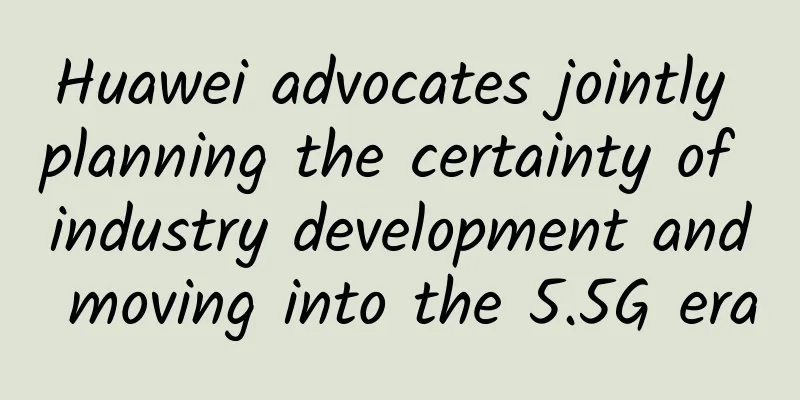Huawei advocates jointly planning the certainty of industry development and moving into the 5.5G era

|
[Barcelona, Spain, March 1, 2023] The "Join Hands to Enter the 5.5G Era" summit was held today during MWC2023 Barcelona. Huawei called on all sectors of the industry to work together to continuously promote industry consensus and commercial deployment in the 5.5G era and accelerate the move towards an intelligent world. Yang Chaobin, senior vice president of Huawei and president of ICT Products and Solutions, said: "With the rapid development of 5G, new business needs are becoming more diversified and complex, which puts higher demands on 5G network capabilities. 5.5G is the only way for the next upgrade and evolution of 5G networks. This has formed a consensus in the industry and is a deterministic industry development trend. With the clear pace of 5.5G (5G-Advanced), F5.5G (F5G-Advanced), and Net5.5G standards, clear spectrum strategies, and the verification of key technologies and diverse application scenarios, the steady progress of industry consensus will surely promote the accelerated arrival of 5.5G network commercialization. The tenfold increase in network capabilities will trigger thousands of industries to release more powerful digital productivity." Yang Chaobin, President of ICT Products and Solutions, delivered a keynote speech entitled "Within Reach, Join Hands to Enter the 5.5G Era" "5.5G" has formed an industry consensus and has become a definite development trend Yang Chaobin said that 6G is still in the early research stage, so 5.5G is the only way for the next upgrade and evolution of 5G networks, and the industry is accelerating the formation of a consensus on this. For the development of the 5.5G industry, it is necessary to work together with the entire industry in four aspects: 1. The pace of industry standards is clear: 5.5G has started the standardization process, and will define 5.5G technical specifications through 3GPP Release18, Release19, and Release20, and continue to enrich the technical content of 5.5G. Release18 will be frozen in H1 2024; F5.5G has been implemented from industry initiatives to standard design. ETSI released the white paper of F5G Advanced in September last year, and the first standard version of F5.5G, Release3, which it led in defining, will be frozen in H1 2024. IETF and IEEE have also fully carried out standard work related to the first phase of Net5.5G, such as SRv6, Wi-Fi 7, and 800GE, and the relevant standards will be fully released in 2024. 2. Clear spectrum resource strategy: Spectrum resources are the cornerstone of wireless networks. The 5.5G industry is jointly promoting the Sub 100GHz spectrum to NR: On the one hand, the current existing spectrum is integrated on demand through spectrum re-farming and gradually moves towards 5.5G; on the other hand, we jointly promote the commercial use of millimeter wave and U6GHz ultra-wide bandwidth spectrum to provide resource guarantee for 5.5G. 3. Steady progress in industry consensus: 5.5G has formed a broad consensus in the industry, and the world's leading operators are actively promoting the formulation of 5.5G standards and technical innovation verification. During this Barcelona exhibition, GSMA led industry partners to form a 5.5G Community. WBBA (World Broadband Association) was also officially established in 2022 and released the Next Generation Broadband Roadmap white paper for F5.5G. OMDIA released the Net5.5G white paper in September last year, aligning industry goals from the perspectives of technology evolution, application scenarios, and industry ecology, aligning industry rhythms, and accelerating the commercialization process. 4. Smooth evolution and protection of investment: 5.5G will achieve on-demand integration of existing 5G network resources through key technologies such as re-farming of existing spectrum and multi-mode multiplexing of equipment, and gradually evolve smoothly to 5.5G, fully protecting operators' existing investments. The continuous maturity of key technologies and the verification of application scenarios have made the 5.5G era within reach Yang Chaobin said that with the joint efforts of the industry, breakthroughs have been made in many key technologies of 5.5G. Innovative technologies such as ultra-large-scale antenna arrays (ELAA) and virtual large carrier reconstruction of non-continuous spectrum (MBSC) in wireless networks have been verified by multiple operators around the world, bringing 5.5G 10G capabilities into reality. In F5.5G fixed networks, 50G PON has been standardized by ITU-T as the next-generation PON. Key technologies such as uplink and downlink symmetry and multi-mode integration continue to develop and mature, laying the foundation for the smooth upgrade and evolution of F5G to F5.5G. The development of 5.5G/F5.5G drives the upgrade of IP networks and opens up Net5.5G. Net5.5G continues to enhance in terms of 800GE ultra-wide, end-to-end IPv6+, intelligence, security, latency, etc., bringing new capabilities, new products and new opportunities to operators, stimulating their continued growth. 5G has entered a period of rapid development after three years of commercial use. By the end of 2022, the number of global 5G users will exceed 1 billion, the number of Gigabit broadband users will reach 100 million, and there will be more than 20,000 5G industry applications. New business needs and innovations have put forward higher requirements for 5G network capabilities. In terms of personal business, with the gradual maturity of immersive services such as XR and holographic communication, the connection experience has moved from Gigabit 1Gbps to 10 Gigabit 10Gbps; in the field of IoT applications, the explosive growth of IoT applications is a deterministic trend. Taking China as an example, the total number of IoT connections in 2022 has exceeded the total number of human connections; industry digitalization has gradually penetrated into the core production system, and more abundant scenarios and needs have emerged, such as high-precision industrial visual AI detection, mine remote control and autonomous driving, and other 5G+cloud+AI fusion application scenarios, which put forward a demand for 1Gbps uplink bandwidth of 5G networks. The 2023 Mobile World Congress will be held in Barcelona, Spain from February 27 to March 2. Huawei's exhibition area is located in the 1H50 booth of Hall 1 of Fira Gran Via. Huawei, together with global operators, industry elites, opinion leaders, etc., will discuss in depth hot topics such as 5G business success, 5.5G new opportunities, green development, and digital transformation, and use the GUIDE business blueprint to move from the prosperous 5G era to the more prosperous 5.5G era. For more details, please refer to: https://carrier.huawei.com/cn/events/mwc2023 |
<<: What is 6G and how close are we to its launch?
>>: Single Pair Ethernet (SPE) and its applications
Recommend
Discussion on 5G+4G wireless network collaboration and key networking technologies
Labs Guide This article starts with analyzing the...
iOVZ VPS in March 20% off monthly payment and 30% off annual payment, South Korea/Los Angeles data center available
iOVZ Cloud has launched a regular promotion in Ma...
5G IoT empowers a new life in the future
So far, the focus on 5G has been mainly on the co...
Illustrated explanation of the past and present of four IO models
Recently, I have come to believe that when explai...
White Box in the Enterprise: Why Isn't It a Popularity?
[[411229]] If you’re in an enterprise CIO, CFO, o...
Wi-Fi Sense: Your home's next sensor may not be a sensor
Part 01 How Wi-Fi Sensing Works Wi-Fi sensing is ...
Competition and Cooperation among the Three Major Industrial Internet Camps
"Short-term cooperation, long-term competiti...
How does machine learning help 5G networks?
Machine Learning Machine learning is a field of e...
5 reasons why DevOps will be a big thing in 2018
DevOps has been a hot topic for a few years now. ...
With high charges and slow speeds, how can operators attract consumers to upgrade to 5G?
5G has been commercially available for a year, an...
Commercial CDN returns to its original intention: focus on details and maximize distribution efficiency
On October 20, Live Video Stackcon 2017 was held ...
HostKvm adds Australian VPS, 40% off 2G memory package starting from $4.2/month
HostKvm has launched a new data center: Australia...
The first batch of commercial 5G networks may not even be able to make phone calls?
01.Everyone is paying attention to the 5G Interne...
Looking back at the journey of Huawei's ICT ecosystem, I would like to give a thumbs up to the partners who have jointly built a prosperous ecosystem!
In June, although the "Huawei China ICT Ecos...
Huawei releases smart security distribution business strategy and four new AI products
[Shenzhen, China, March 20, 2020] Today, Huawei&#...









